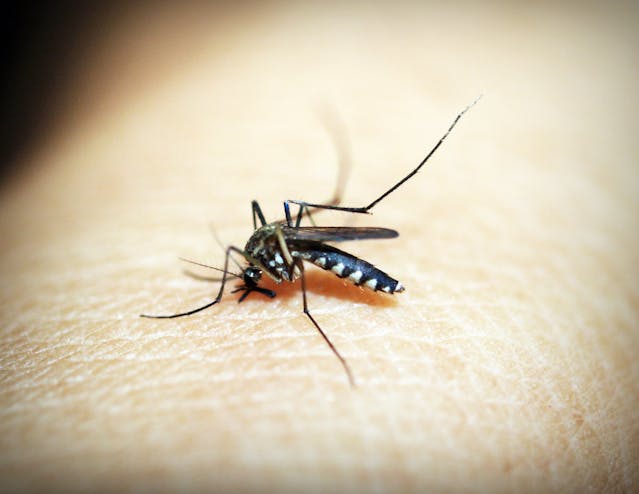
What causes malaria? It is caused by a parasite of the Plasmodium group and it is spread through the bite of a female Anopheles mosquito.
The parasite is said to be from a group because there are five different parasites. They are called Plasmodium falciparum, Plasmodium vivax, Plasmodium Malariae, Plasmodium ovale, and Plasmodium knowlesi. The first our parasites are exclusive to humans, but the last one can also infect macaque monkeys.
The name of the disease, malaria, comes from Italian. Mal means bad and aria means air, so it meant bad air. The disease is usually associated with marshy areas that have bad air, so it made sense. These days, we associate malaria with African countries, but it has only been brought under control in Europe fairly recently. In southern Europe, mosquitos and malaria were such a problem that it was called “Roman Fever”, and some people think it may have had a part to play in the decline of the Roman empire. The phrase mal’aria was first used in 1740, but for several diseases. It was first used to refer to the malaria disease in 1866. In the 19th century, diseases like cholera and hospital born infections were often attributed to bad air. The fact that malaria was caused by mosquitos carrying a parasite wasn’t known until 1880. Interestingly, malaria has existed for hundreds of thousands of years, but it only became a problem when early humans domesticated animals and started to live in larger communities. The population began to expand and mosquitos had an easier to find food source that was located in one place. Mosquitos increased in line with the food source.
How does infection work? The parasite is microscopic and it starts inside the gut of the mosquito. From there, it works its way to the mosquito’s salivary glands and starts to multiply. When the mosquito bites a person, they inject saliva to numb the area and to keep the blood in the wound from congealing. When they inject this saliva, they also inject the parasite. Once in the human bloodstream, the parasite is carried to the liver where they exit the blood and enter cells. Once in those cells, sometimes straight away and sometimes after a few days, they start to reproduce. They reproduce rapidly and within a few days, there are thousands of them. As they increase, the cells they are reproducing in rupture and the parasites flow out into the blood stream. Once there, they start to invade red blood cells. The parasite reproduces again until the red blood cell is full and then they break out to go and find more red blood cells to infect. The infected red blood cells are in the blood and if the person is bitten by another mosquito, the infected cells can go into that mosquito and start the whole cycle again. A chicken and an egg situation.
The malaria parasite has several ways to avoid being destroyed by our immune systems. Firstly, while it is hidden inside liver cells or hidden inside red blood cells, the immune system cannot see it and it is safe. It is only when it breaks out of the red blood cells to find more that our immune response starts, which is why people with malaria get waves of fever. Every time the parasites come out, they get a fever, and when the parasites are back in a red blood cell, the fever goes away. Secondly, the parasites can make knobs form on the outside of the red blood cell to attach it to the blood vessel. The spleen is the most dangerous place for the parasite and keeping the red blood cell in one place prevents it going through the spleen. For these reasons, the body is not able to kill the parasite and drugs are necessary. Antimalarial drugs work by killing the parasite in one of several ways. However, even when the parasite has been killed, there is the chance that there are still dormant parasite cells in the liver that could wake up at any time.
Malaria has been wiped out in wealthy countries because the drugs to kill the parasites are readily available and the areas where the mosquitos grow have been eliminated. In many African countries, the risks are very high and malaria is often fatal. It is estimated that 600,000 people die of malaria each year, and these are preventable deaths. Almost all happen in poor African countries that are undergoing civil wars or are failed states. Malaria kills in several ways. When the parasites make the blood cells attach to the edge of the blood vessel, they can block small capillaries into the brain. Fluid can build up in the lung. The organs can fail. There can be liver failure or the spleen can rupture. There can be a lack of oxygen going around the body, and several other ways. The fact that people no longer die of malaria in hot wealthy European countries, shows that all of these are preventable deaths. And this is what I learned today.
Photo by icon0 com: https://www.pexels.com/photo/black-mosquito-on-person-s-skin-169357/
Sources
https://www.mayoclinic.org/diseases-conditions/malaria/symptoms-causes/syc-20351184
https://en.wikipedia.org/wiki/Malaria
https://www.who.int/news-room/fact-sheets/detail/malaria
https://www.ncbi.nlm.nih.gov/pmc/articles/PMC7792015
https://www.ncbi.nlm.nih.gov/pmc/articles/PMC10237628
https://www.etymonline.com/word/malaria

Pingback: What is DDT?